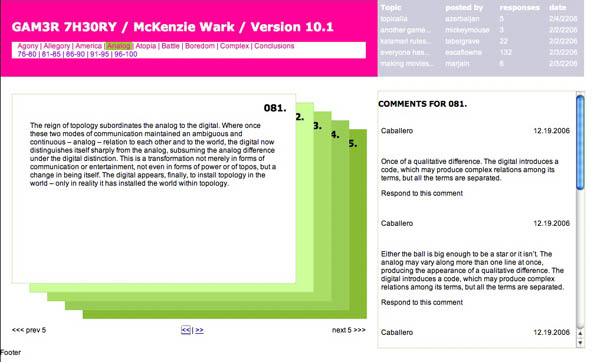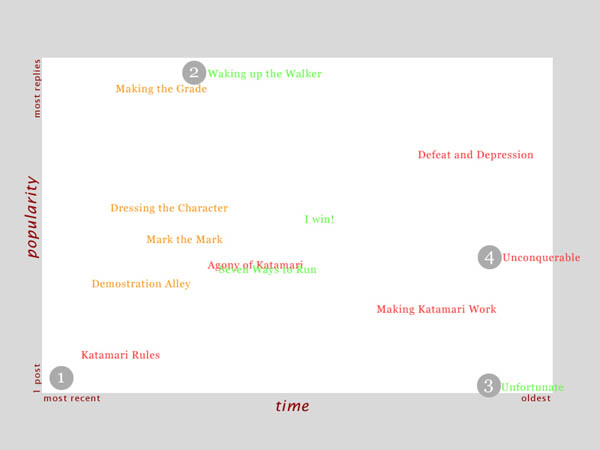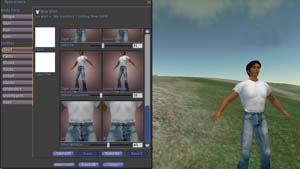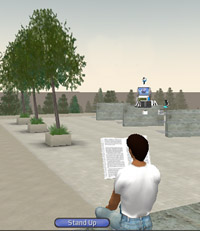This apparently made the blog rounds recently, but I just saw it for the first time tonight in a movie theater and was mighty impressed:
And a twist on this: check out this Washington Post article on live ads in video games.
Category Archives: video_games
“highbrow” video games?
 Recently in the gaming blog Gamersutra, Ernest Adams questions why aren’t there highbrow video games.” His article comes one month after an Esquire article, where Chuck Klosterman wondered why isn’t there good video game criticism and makes the claim that video games needs its own Lester Bangs. As the video game market grows, it is not surprising that fans and advocates of gaming will want to form to grow and mature as well.
Recently in the gaming blog Gamersutra, Ernest Adams questions why aren’t there highbrow video games.” His article comes one month after an Esquire article, where Chuck Klosterman wondered why isn’t there good video game criticism and makes the claim that video games needs its own Lester Bangs. As the video game market grows, it is not surprising that fans and advocates of gaming will want to form to grow and mature as well.
Adams’ call for “highbrow” games is rooted in a desire to add creditability and legitimacy to video games. As someone who has dedicated his career to making and writing about video games, the never-ending criticism about the violence in games by various groups looking for easy political targets must be frustrating to endure. I can appreciate the motivations behind Adam’s conclusion, however, his description of highbrow video games is ultimately too narrowly defined and overlooks impressive experiments of video games.
I hesitate to even try to deem games “high” or “low” because the terms are not that useful. Adams specifically points out that the films he aspires video games to emulate are not “art films,” which he describes as a “short low-budget titles filled with impenetrable weirdness.” Therefore, his definition of highbrow edge towards the problematic “I know it when I see it” definitions of art. Further, we can gather insight on culture and ourselves by interacting will both high and low culture and valuing one form over another is problematic.
From his description of a highbrow video game, I think what Adams is really asking for is better interactive narratives in gaming. He alludes to the films of Ishmail Merchant and James Ivory, who are best known for adopting the novels of E.M. Forester, often with screenwriter Ruth Prawer Jhabvala. Their films tend to be beautiful, well crafted analyses of class. Although, they are not generally know for pushing the boundaries of film.
Last year, Adams gave a talk which he published on his website, in which he assesses the state of interactive narrative. It provides more insight on his train of thought. In it, one of his references in video game scholarship is Janet Murray’s Hamlet on the Holodeck which uses a theatrical frame of reference in postulating the future of interactive narrative. Also, Adams offers a model of a “structured” approach to the narrative of video games and reveals that he is particularly wedded to the idea of single player games over the shared gaming experience of MMORPGs which are increasingly popular. In his current essay, his description of states that the highbrow video game “would reward close attention and playing more than once.” This implies that he still leans towards single player role playing games in his conceptualization of highbrow games.
However, video games that are pushing the form in more “artistic” ways are occurring outside the bounds of single player game. For example, we-make-money-not-art reported on The Endless Forest, which is a gorgeous MMORPG in which players assume the identity of a deer. Developed by the Belgian studio Tale of Tales, The Endless Forest has an elegant interface and darkly rich art direction. Although it lacks an explicit narrative, the gameplay engages users without the typical violence and sexually charged themes of many games. The Endless Forest limits the use of language. Therefore, it does not include a chat function and players are “named” with pictograms rather than words. However, as more of these kinds of games are created, they are unlikely to lessen the criticism of the negative social effects of video games.
As for criticism, the notion of elevating video game criticism to a higher form is rather ironic, as it comes at the same time when the New York Times critic A.O. Scott finds himself defending film criticism. While not a music critic, Scott describes the critics’ predicament that often panned movies are still hugh box offices successes. Media critics want the new and interesting, which is somewhat expected if it is your job to watch and write about movies, music, or video games everyday. Their standards are quite different from the typical audience member. Lester Bangs was a polarizing figure, who wanted to raise the standards of writing on music. He appeared at a time when people were ready for similar standards. It may be that a critical mass of audience for a similar kind of criticism for gaming is beginning to emerge.
As previously stated, most gamers will still want “mainstream” titles. Because games are expensive, they will still rely on criticism which Klosterman dismissives as “customer advice.” That is, many gamers, if not most, will still mostly be interested in reading reviews which describe gameplay, graphics and sound design, rather than thematic and issues of meaning. Many gamers don’t like the academic scholarly writing on video games, which is in adbundance, but is not what Klosterman wants to read. We learned about their attitutdes in initial reactions and comments posted across the gaming blogosphere about our project “GAM3R 7H30RY.” It’s not clear to me what is bad about gaming publications serving the desires of the video game playing community.
 My guess is that both boundary pushing video games and criticism will be begin to get more exposure fairly soon. For the actual video games, I would look towards Europe and Asia, where more government funding exists for developing these kinds of endeavors. I don’t expect many of the big gaming companies in the US to create experimental games of this nature. Although, they might in the future, after the proven economic viability of them. In that, major movie studios started funding more smaller films after they saw successful crossover of films of the Merchant Ivory variety. Although, Rockstar (the maker of Grand Theft Auto) have the upcoming and already controversial game Bully, where you must navigate a boarding school as a new student. It was described by the New York TImes as having, “an open world for the players to explore, tightly defined and memorable characters, a strong story line, [and] high-end voice acting,” which is precisely what Adams call for in his article.
My guess is that both boundary pushing video games and criticism will be begin to get more exposure fairly soon. For the actual video games, I would look towards Europe and Asia, where more government funding exists for developing these kinds of endeavors. I don’t expect many of the big gaming companies in the US to create experimental games of this nature. Although, they might in the future, after the proven economic viability of them. In that, major movie studios started funding more smaller films after they saw successful crossover of films of the Merchant Ivory variety. Although, Rockstar (the maker of Grand Theft Auto) have the upcoming and already controversial game Bully, where you must navigate a boarding school as a new student. It was described by the New York TImes as having, “an open world for the players to explore, tightly defined and memorable characters, a strong story line, [and] high-end voice acting,” which is precisely what Adams call for in his article.
Regardless of who moves video games and its coverage further, it’s bound to happen. Although, these new forms may not look exactly has Adams and Klosterman describe or wish. Media takes time to evolve, just compare the “highbrow” television series the HBO produces as compared to rather “lowbrow” television from the 50s. (I will admit that I don’t prefer one over the other.) For a great example of how a medium transforms the perspective of an artist, see Scott McCloud’s description of the movement from comic book fan to student to professional to genre pushing pioneer in Understanding Comics. If someone really wants to write video game criticism in the style of Lester Bangs, then the current low barriers of entry to electronic self-publishing allows her to do so. Creating video games, of course, requires a lot more resources. However, in closing, Adams states, “maybe I’ll design one myself, just for the fun of it.”
war machinima
Ray, Bob and I spent last week out in Los Angeles at our institutional digs (the Annenberg Center for Communication at USC), where we held a pair of meetings with professors from around the US and Canada to discuss various coups we are attempting to stage within the ossified realm of scholarly and textbook publishing. Following these, we were able to stick around for a fun conference/media festival organized by Annenberg’s Networked Publics project.
The conference was a mix of the usual academic panels and a series of curated mini-exhibits of “do-it-yourself” media, surveying new genres of digital folk art currently proliferating across the net such as political remix movies, anime music videos, “digital handmade” art projects (which featured the near and dear Alex Itin — happy birthday, Alex!), and of course, machinima: films made inside of video game engines.
 As we enjoyed this little feast of new media, I was vaguely aware that the Tribeca film festival was going on back in New York. As I casually web-surfed through one of the panels — in the state of continuous partial attention that is now the standard state of being all these networky conferences — I came across an article about one of the more talked about films appearing there this year: “The War Tapes.” Like Gunner Palace and Occupation Dreamland, “The War Tapes” is a documentary about American soldiers in Iraq, but with one crucial difference: all the footage was shot by actual soldiers.
As we enjoyed this little feast of new media, I was vaguely aware that the Tribeca film festival was going on back in New York. As I casually web-surfed through one of the panels — in the state of continuous partial attention that is now the standard state of being all these networky conferences — I came across an article about one of the more talked about films appearing there this year: “The War Tapes.” Like Gunner Palace and Occupation Dreamland, “The War Tapes” is a documentary about American soldiers in Iraq, but with one crucial difference: all the footage was shot by actual soldiers.
Back in 2004, director Deborah Scranton gave video cameras to ten members of the New Hampshire National Guard who were about to depart for a yearlong tour in Iraq. They went on to shoot a combined 800 hours of film, the pared-down result of which is “The War Tapes.” Reading about it, I couldn’t help but think that here was a case of real-life machinima. Give the warriors cameras and glimpse the war machine from the inside — carve out a new game within the game.
Granted, it’s a far from perfect analogy. Machinima involves a total repurposing of the characters and environment, foregoing the intended objectives of the game. In “The War Tapes,” the soldiers are still on their mission, still within the chain of command. And of course, war isn’t a video game. But isn’t it advertised as one?
Time Square, New York City (the military-entertainment complex)
There’s something undeniably subversive about giving cameras to GIs in what is such a thoroughly mediated war, a sort of playing against the game — if not of the game of occupation as a whole, then at least the game of spin. “I’m not supposed to talk to the media,” says one soldier to Steve Pink, one of the film’s main subjects, as he attempts to conduct an interview. To which Pink replies: “I’m not the media, dammit!”
In the clips I found on the film’s promotional site (the general release is later this summer), the overriding impression is of the soldiers’ isolation and fear: the constant terror of roadside bombs, frantic rounds fired into the green night-vision darkness, swaddled in helmets and humvees and hi-tech weaponry. It’s a frightening game they play. Deeply impersonal and anonymous, and in no way resembling the pumped-up, guitar-screeching game that the military portrays as war in its recruiting ads. This is the horrible truth at the bottom of the “Army of One” slogan: you are a lone digit in a massive calculation. Just pray you don’t become a zero.
Yet naturally, they find their own games to play within the game. One clip shows the tiny, gruesome spectacle of two soldiers, in a moment of leisure, pitting a scorpion against a spider inside a plastic tub, reenacting their own plight in the language of the desert.
At the Net Publics conference, we did see see one example of genuine machinima that made its own spooky commentary on the war: a hack of Battlefield 2 by Swedish game forum Snoken that brilliantly apes the now-famous Sony Bravia commercial, in which 250,000 colored plastic balls were filmed cascading through the streets of a San Francisco.
Here’s Battlefield:
And here’s the original Sony ad:
McKenzie Wark doesn’t address machinima in GAM3R 7H30RY (which launches in about a week), but he does discuss video games in the context of the “military entertainment complex”: the remaking of postmodern capitalist society in the image of the digital game, in which every individual is a 1 or a 0 locked in senseless competition for advancement through the levels, each vying to “win” the game:
The old class antagonisms have not gone away, but are hidden beneath levels of rank, where each agonizes over their worth against others in the price of their house, the size of their vehicle and where, perversely, working longer and longer hours is a sign of winning the game. Work becomes play. Work demands not just one’s mind and body but also one’s soul. You have to be a team player. Your work has to be creative, inventive, playful – ludic, but not ludicrous.
Video games (which can actually be won) are allegories of this imperfect world that we are taught to play like a game, as though it really were governed by a perfect (and perfectly fair) algorithm — even the wars that rage across its hemispheres:
Once games required an actual place to play them, whether on the chess board or the tennis court. Even wars had battle fields. Now global positioning satellites grid the whole earth and put all of space and time in play. Warfare, they say, now looks like video games. Well don’t kid yourself. War is a video game – for the military entertainment complex. To them it doesn’t matter what happens ‘on the ground’. The ground – the old-fashioned battlefield itself – is just a necessary externality to the game. Slavoj Zizek: “It is thus not the fantasy of a purely aseptic war run as a video game behind computer screens that protects us from the reality of the face to face killing of another person; on the contrary it is this fantasy of face to face encounter with an enemy killed bloodily that we construct in order to escape the Real of the depersonalized war turned into an anonymous technological operation.” The soldier whose inadequate armor failed him, shot dead in an alley by a sniper, has his death, like his life, managed by a computer in a blip of logistics.
How does one truly escape? Ultimately, Wark’s gamer theory is posed in the spirit that animates the best machinima:
The gamer as theorist has to choose between two strategies for playing against gamespace. One is to play for the real. (Take the red pill). But the real is nothing but a heap of broken images. The other is to play for the game (Take the blue pill). Play within the game, but against gamespace. Be ludic, but also lucid.
sonogram of networked book in embryo (GAM3R 7H30RY part 3)
It probably won’t be until mid to late March that we finally roll out McKenzie Wark’s GAM3R 7H30RY Version 10.1, but substantial progress is being made. Here’s a snapshot:

After debating (part 1) our way to a final design concept (part 2), we’re now focused (well, mainly Jesse at this point) on hammering the thing together. We’re using all open source software and placing the book under a Creative Commons Attribution-NonCommercial-ShareAlike 2.0 license. Half the site will consist of a digital edition of the book in Word Press with a custom-built card shuffling interface. As mentioned earlier, Ken has given us an incredibly modular structure to work with (a designer’s dream): nine chapters (so far), each consisting of 25 paragraphs. Each chapter will contain five five-paragraph stacks with comments popping up to the side for whichever card is on top. No scrolling is involved except in the comment field, and only then if there is a substantial number of replies.
The graphic above shows the color scale we’re thinking of for the different chapters. As they progress, each five-card stack will move from light to dark within the color of its parent chapter. Floating below the color spectrum is the proud parent of the born-digital book: McKenzie Wark, Space Invader (an image that will appear in some fashion throughout the site). Right now he’s a fairly mean-looking space invader — on a bombing run or something. But we’re thinking of shuffling a few pixels to give him a friendlier appearance.
You are also welcome to view an interactive mock-up of the card view (click on the image below):

The other half of the site will be a discussion forum set up in PHP Bulletin Board. Actually, it’ll be a collection of nine discussion forums: one for each chapter of the book, each focusing (except for the first, which is more of an introduction) on a specific video game. Here’s how it breaks down:
* Allegory (on The Sims)
* America (on Civilization III)
* Analog (on Katamari Damarcy)
* Atopia (on Vice City)
* Battle (on Rez)
* Boredom (on State of Emergency)
* Complex (on Deus Ex)
* Conclusions (on SimEarth)
The gateway to each forum will be a two-dimensional topic graph where forum threads float in an x-y matrix. Their position in the graph will be determined by the time they were posted and the number of comments they’ve accumulated so far. Thus, hot topics will rise toward the top while simultaneously being dragged to the left (and eventually off the chart) by the progression of time. Something like this:

At this point there’s no way of knowing for sure which part of the site will be more successful. The book view is designed to gather commentary, and Ken is sincerely interested in reader feedback as he writes and rewrites. There will also be the option of syndicating the book to be digested serially in an RSS reader. We’re very curious to see how readers interact with the text and hope we’ve designed a compelling environment in which to do so.
Excited as we are about the book interface, our hunch is that the discussion forum component has the potential to become the more vital half of the endeavor. The forum will be quite different from the thousands of gaming sites already active on the web in that it will be less utilitarian and more meditative in its focus. This won’t be a place for posting cheats and walk-throughs but rather a reflective space for talking about the experience of gaming and what players take games to mean. Our hope is that people will have quite a bit to say about this — some of which may end up finding its way into the book.
Although there’s still a ways to go, the process of developing this site has been incredibly illuminating in our thinking about the role of the book in the network. We’re coming to understand how the book might be reinvented as social software while still retaining its cohesion and authorial vision. Stay tuned for further developments.
GAM3R 7H30RY: a work in progress… in progress

I’m pleased to report that the institute is gearing up for another book-blog experiment to run alongside Mitchell Stephens’ ongoing endeavor at Without Gods — this one a collaboration with McKenzie Wark, professor of cultural and media studies at the New School and author most recently of A Hacker Manifesto. Ken’s next book, Gamer Theory, is an examination of single-player video games that comes out of the analytic tradition of the Frankfurt School (among other influences). Unlike Mitch’s project (a history of atheism), Ken’s book is already written — or a draft of it anyway — so in putting together a public portal, we are faced with a very different set of challenges.
As with Hacker Manifesto, Ken has written Gamer Theory in numbered paragraphs, a modular structure that makes the text highly adaptable to different formats and distribution schemes — be it RSS syndication, ebook, or print copy. We thought the obvious thing to do, then, would be to release the book serially, chunk by chunk, and to gather commentary and feedback from readers as it progressed. The trouble is that if you do only this — that is, syndicate the book and gather feedback — you forfeit the possibility of a more free-flowing discussion, which could end up being just as valuable (or more) as the direct critique of the book. After all, the point of this experiment is to expose the book to the collective knowledge, experience and multiple viewpoints of the network. If new ideas are to be brought to light, then there ought to be ways for readers to contribute, not just in direct response to material the author has put forth, but in their own terms (this returns us to the tricky proprietary nature of blogs that Dan discussed on Monday).
So for the past couple of weeks, we’ve been hashing out a fairly ambitious design for a web site — a blog, but a little more complicated — that attempts to solve (or at least begin to solve) some of the problems outlined above. Our first aim was to infuse the single-author book/blog with the democratic, free-fire discussion of list servers — a feat, of course, that is far easier said than done. Another concern, simply from an interface standpoint, was to find ways of organizing the real estate of the screen that are more intuitive for reading.
Another thing we’ve lamented about blogs, and web sites in general, is their overwhelming verticality. Vertical scrolling fields — an artifact of supercomputer terminals and the long spools of code they spit out — are taken for granted as the standard way to read online. But nowhere was this ordained as the ideal interface — in fact it is designed more for machines than for humans, yet humans are the users on the front end. Text does admittedly flow down, but we read left to right, and its easier to move your eye across a text that is fixed than one that is constantly moving. A site we’ve often admired is The International Herald Tribune, which arranges its articles in elegant, fixed plates that flip horizontally from one to the next. With these things in mind, we set it as a challenge for ourselves to try for some kind of horizontally oriented design for Ken’s blog.
There’s been a fairly rigorous back and forth on email over the past two weeks in which we’ve wrestled with these questions, and in the interest of working in the open, we’ve posted the exchange below (most of it anyway) with the thought that it might actually shed some light on what happens — from design and conceptual standpoints — when you try to mash up two inherently different forms, the blog and the book. Jesse has been the main creative force behind the design, and he’s put together a lovely annotated page explaining the various mockups we’ve developed over the past week. If you read the emails (which are can be found directly below this paragraph) you will see that we are still very much in the midst of figuring this out. Feedback would be much appreciated. (See also GAM3R 7H30RY: part 2).
letters from second life

Last week, Bob mentioned that Larry Lessig, law profressor and intellectual property scholar, was being interviewed in Second Life, the virtual world created by Linden Lab. Having heard a lot of Second Life before, I was pleased to have a reason and opportunity to create an account and explore it. Basically I quickly learned that it’s Metaverse, as described in Neil Stephenson’s Snowcrash, in operation today, and I’m now a part of it too.
I already covered the actual interview. Here are a few observations from my introduction to SL.
Second Life is a humbling place, especially for beginners. Everything ,even the simplest things, must be relearned. It took me 5 minutes to learn how to sit down, another 5 minutes to read something, and on and on. Traveling to the site of Lessig event was an even more daunting task. I was given the location of this event, a name and coordinates, without any idea of what to do with them. Second Life is a vast space, and it wasn’t clear to me how to get from one point to another. I had no idea how to travel in SL, and had to ask around someone.
I presume it is evident that I’m very new to SL, by my constant trampling over people and inanimate objects. So, I continue walking into trees and rocks until I come across someone whose title contains “Mentor,” and figure that this is a good person to ask for help. Not knowing how to strike up a private conversation, I start talking out loud, not even sure if anyone is even going to pay attention.
(I will come to learn that you travel from place to place via teleportation.)
“Hi.”
“Hi Harold.”
I am relieved to discover that people are basically nice in SL, maybe even nicer than in New York. This fellow avatar is happy to chat and answer questions. Second List has a feature called “Friends” which operates like Buddies in Instant Messaging. However, I’m not sure what the social protocol for making friends is, so I make no assumptions. As I was typing “can we be friends?” I sigh with the realization that I am, in fact, back in fourth grade.
 People around me have much more sophisticated outfits than I do. So, I try out the free clothing features. I darken my pants to a deep blue and my shoes black. Then, my default shirt gets turned into a loose white t-shirt. Somehow I end up a bit like a GAP model crossed with Max Headroom. After making my first “friend,” another complete stranger comes up to me and just starts giving me clothes. Apparently, my clothes still need a little work. I try on the cowboy boots and faded jeans. Happy that I’ve moved beyond the standard issue clothes, I thank my benefactor and begin to make my way to the event.
People around me have much more sophisticated outfits than I do. So, I try out the free clothing features. I darken my pants to a deep blue and my shoes black. Then, my default shirt gets turned into a loose white t-shirt. Somehow I end up a bit like a GAP model crossed with Max Headroom. After making my first “friend,” another complete stranger comes up to me and just starts giving me clothes. Apparently, my clothes still need a little work. I try on the cowboy boots and faded jeans. Happy that I’ve moved beyond the standard issue clothes, I thank my benefactor and begin to make my way to the event.
The builders of Second Life force people to rely on other people within the virtual world. However, assistance in the real world certainly helps too. Entering Second Life, the feeling of displacement is quite clear, as if I arrived to a new city in the real world with a single address, where I don’t know anyone or how to navigate the city. The virtual world often mimics the real world, but my surprise each time I learn this fact is still ongoing. It definitely helps to know people, both in where to go that’s interesting and how to do things.
After teleporting to the event, I found myself around people who had common interests, which was great and similar to attending a lecture in the real world. At different times, I struck up a conversation with an avatar who is a publisher on the West Coast and then talked to an academic who runs a media center. In both cases, I was talking to the person literally “next” to me.
When I first heard about the interview, I learned at there was limited spacing. Which seemed strange to me, as it was taking place in a viritual space. When I arrived at the event place, I saw the ampitheater with video screens, that would show a live web stream of Lessig. The limited seating made more sense, seeing the seat of the theater. I also believe that the SL servers also have a finite capacity for the number of people to be located within a small area, because movement was jerky around concentrated groups of people. I guess I’ll have to wait for the Second Life Woodstock.
The space was crowded with people walking around, chatting, and getting up their free digital copy of Lessig’s book, “Free Culture.” (I’ve included a picture of me reading Free Culture in Second Life. You can actually read the text.)  The interview is about to begin, as an avatar with large red wings walks by me. I say out loud, “I know she was going to sit in front of me.” Adding, “Just kidding,” in case I might be offending someone, who knows who this person could be. Fortunately, she found a seat outside my sight line without incident, and the introductory remarks began.
The interview is about to begin, as an avatar with large red wings walks by me. I say out loud, “I know she was going to sit in front of me.” Adding, “Just kidding,” in case I might be offending someone, who knows who this person could be. Fortunately, she found a seat outside my sight line without incident, and the introductory remarks began.
There was a strange duality where I had to both learn what was being said, but also how to navigate the environment of a lecture as well. The interview proceeds within the social norms of a lecture. People are mostly quiet, clap and for the moderator runs the question and answer session. Afterwards, I line up to get Lessig to “sign” my virtual book at the virtual booksigning, as in my virtual public event. I finally stumble my way through the line, all the while asking many question on what I’m supposed to do. With my signed book in hand, I look at the sky, which is quite dark. I log out and return to the real world.
line between the real and game space… a peek into the future?
As Lisa noted in her comment to an previous post on class and gaming, the Economist reviewed the new book by Edward Castronova entitled, Synthetic Worlds : The Business and Culture of Online Games.
Castronova, also wrote an essay that was included in the Game Design Reader that was behind the “Making Games Matter” panel we attended. This essay marks the first analysis of the economics of people and their interactions in a virtual reality. Interesting to note, it has yet to be formally published in an academic economics journal.
In these studies, Castronova calculates the economics of the virtual by looking at what people are willing to pay in real currency for online gaming characters and their associated costs. As previously posted, people are making their livings in these virtual spaces by creating and selling their avatars. We are entering an era where the boundaries between the real and virtual are blurring.
Although some affluent gamers are buying their way into the higher echelons of game spaces such as EverQuest, there is still the opportunity for anyone with enough time and skill to create advanced characters. Where as in the real world, there are only a limited number of players in the NBA and CEO positions in the Fortune 500 companies. There is enough “room” in the game space to allow for many top tier characters, because the vast majority of the “normal” characters are bots run by the gaming engine.
Is the online game space the utopian society where everyone can be equal and rich and powerful? Is this a peek at the future of the real world when robots take over all the jobs that people don’t want to perform?
last week: wikipedia, r kelly, gaming and google panels, and more…
Here’s an overview of what we’ve been posting over the last week. As well, a few of us having been talking about ways to graphically represent text, so I thought I would include a mind map of this overview.
As a follow up to the increasingly controversial wikipedia front, Daniel Brandt uncovered that Brian Chase posted false information about John Seignthaler that was reported here last week. To add fuel to the fire, Nature weighed in that Encyclopedia Britannica may not be as reliable as Wikipedia.
Business Week noted a possible future of pricing for data transfer. Currently, carries such as phone and cable companies are developing technology to identify and control what types of media (voice, images, text or video) are being uploaded. This ability opens the door to being able to charge for different uses of data transfer, which would have a huge impact on uploading content for personal creative use of the internet.
Liz Barry and Bill Wetzel shared some of their experiences from their “Talk to Me” Project. With their “talk to me” sign in tow, they travel around New York and the rest of the US looking for conversation. We were impressed at how they do not have a specific agenda besides talking to people. In the mediated age, they are not motivated by external political/ religious/ documentary intentions. What they do document is available on their website, and we look forward to see what they come up with next.
The Google Book Search debate continues as well, via a panel discussion hosted by the American Bar Association. Interestingly, publishers spoke as if the wide scale use of ebooks is imminent. More importantly and even if this particular case settles out of court, the courts have a pressing need to define copyright and fair use guidelines for these emerging uses.
With the protest of the WTO meetings in Hong Kong this past week, new journalism forms took one step forward. The website Curbside @ WTO covered the meetings with submissions from journalism students, bloggers and professional journalists.
McDonalds filed a patent which suggests that it intends to offer clips of movies instead of the traditional toys in their kids oriented Happy Meals. Lisa pondered if a video clip can successfully replace a toy, and if it does, what the effects on children’s imaginations might be.
R. Kelly’s experiments in form and the “serial song” through his Trapped in the Closet recordings. While R Kelly has varying success in this endeavor, Dan compared the experience of not only the serial novel, but also Julie Powell’s foray into transferring her blog into book form and what she might have learned from R. Kelly (its hard to make unified pieces maintain an overall coherency.)
The world of academic publishing was challenged with a proposal calling to create an electronic academic press. This segment seems especially ripe for the shift to digital publishing as many journals with small circulations face raising printing and production costs.
Sol and others from the institute attended “Making Games Matter,” a panel with contributors from The Game Design Reader: A Rules of Play Anthology, edited by Katie Salen and Eric Zimmerman. The discussion covered among other things: involving the academy in creating a discourse for gaming and game design, obstacles in studying and creating games, and the game “industry” itself. The book and panel called out for games and gaming to undergo a formal study akin to the novel and the experience of reading. Also, in the gaming world, the class economics of the real and virtual began to emerge as a Chinese firm pays employees to build up characters in MMOGs to sell to affluent gamers.
off to seoul
Over the next couple of weeks I will be traveling in South Korea, the land that invented moveable type (1234), and which to this day is cooking up the future of the book on a high flame: from massivly multiplayer online games, to Samsung’s Ubiquitous Dream Hall, to the massively multiplayer citizen journalism site OhmyNews. It will take me about 20 hours to get there but I feel I’ll be stepping a few years into the future. I expect… well, I have no idea what to expect. And all this futurama is only the tip of the iceberg. I have a camera and it shouldn’t be too hard to find an internet connection, so expect a few postcards.
gaming and the academy
So, what happens when you put together a drama professor and a computer science one?
You get an entertainment technology program. In an article, in the NY Times, Seth Schiesel talks about the blossoming of academic programs devoted entirely to the study and development of video games, offering courses that range from basic game programming to contemporary culture studies.
Since first appearing about three decades ago, video games are well on their way to becoming the dominant medium of the 21st century. They are played across the world by people of all ages, from all walks of life. And in a time where everything is measured by the bottom line, they have in fact surpassed the movie industry in sales. The academy, therefore, no matter how conservative, cannot continue to ignore this phenomenon for long. So from The New School (which includes Parsons) to Carnegie Mellon, prestigious colleges and universities are beginning to offer programs in interactive media. In the last five years the number of universities offering game-related programs has gone from a mere handful to more than 100. This can hardly be described as widescale penetration of higher education, but the trend is unmistakable.
The video game industry has a stake in advancing these programs since they stand to benefit from a pool of smart, sophisticated young developers ready upon graduation to work on commercial games. Bing Gordon, CEO of Electronic Arts says that there is an over-production of cinema studies professionals but that the game industry still lacks the abundant in-flow of talent that the film industry enjoys. Considering the state of public education in this country, it seems that video game programs will continue flourishing only with the help of private funds.
The academy offers the possibility for multidisciplinary study to enrich students’ technical and academic backgrounds, and to produce well-rounded talents for the professional world. In his article, Schiesel quotes Bing Gordon:
To create a video game project you need the art department and the computer science department and the design department and the literature or film department all contributing team members. And then there needs to be a leadership or faculty that can evaluate the work from the individual contributors but also evaluate the whole project.
These collaborations are possible now, in part, because technology has become an integral part of art production in the 21st century. It’s no longer just for geeks. The contributions of new media artists are too prominent and sophisticated to be ignored. Therefore it seems quite natural that, for instance, an art department might collaborate with faculty in computer science.

